by Michael S. Howard
This is a continuation of "Dionysus and the Historical Tarot 2" - Part III, the third part of four, has the following sections:
B1: Bagatella. B2: Imperatrice. B3: Imperatore. B4: Papessa. B5: Papa. B6: Amore. B7: Carro Triomphale. B8: Ruota. B9: Vecchio. B10: Temperanza. B11: Fortezza. B12: Justizia.
B1: Bagatella
So now I will proceed through the rest of the trumps, just to show some of the associations that would likely have been made by a literate person, as an ongoing project from the late 15th to the early 18th century. I am greatly indebted to Daimonax at http://www.bacchus.org for his presentation of this interpretation several years ago; here I will go in my own way, with many additions and some subtractions (for citations that were known only after the 18th century, such as things at Pompeii). Let me make it clear that I do not believe that an initiation into the Mysteries of Dionysus was the original impetus or meaning of the cards; nor is it the only way of seeing the cards, or the only influence on the cards once Dionysus might have started being a factor. It is also important to remember that in this period educated Europeans would have followed the lead of the ancient writers in considering Dionysus and Osiris two forms of the same god in different countries, with similar rites.
Although the Matto was sometimes given the number 0 (explicitly so in the Sola-Busca of c. 1491), the card known in English as the Magician was fhe first numbered card. In the earliest lists, from Ferrara and Venice, he was called the Bagatella. Occasionally he is called the Bagatino; for Alciati, 1444, unusually, he is the Innkeeper. In France he was the Bateleur.
To all appearances this figure is merely a common street conjurer. In the myty of Dionysus, however, however, he would be Dionysus himself, who as the "stranger" in Euripides' Bacchae who concocts illusions to deceive Pentheus, his opponent. Dionysus is also the master of real magic, As a child he turned pirates into dolphins, and his fennel stalk thyrsis is the prototypical magician's wand; here is an illustration from the 1647 edition of Cartari's Images of the Gods of the Ancients, which was first published 1556.
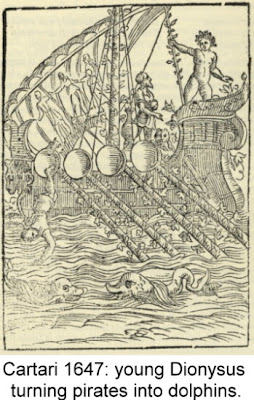
The Bagatella's table suggests the trays of sacred objects seen on Dionysian sarcophagi:
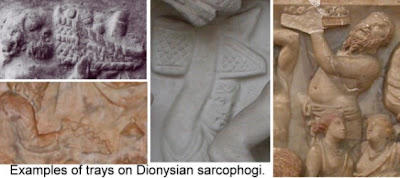
These are described by Clement of Alexandria (http://www.theoi.com/Text/ClementExhortation1.html):
§ «And it is worthwhile to quote the worthless symbols of this rite of yours in order to excite condemnation: the knuckle-bone, the ball, the spinning-top, apples, wheel, mirror, fleece!» §
The knuckle-bones, at least, are often seen on the Bagatella's table in the form of dice (at left below, Noblet c. 1650).
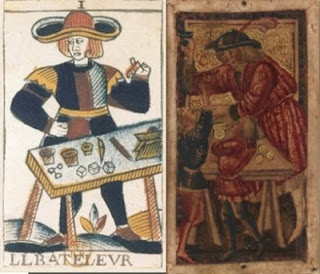
The d'Este Bagatella (at right above), is shown surrounded by children: This figure might correspond to the Titans as described by Clement:
§ «He was yet a child, and the Curetes were dancing around him with warlike movement, when the Titans stealthily drew near. First they beguiled him with childish toys, and then, - these very Titans - tore him to pieces, though he was but an infant» §
In this context, the Bagatella is a nefarious seducer to be avoided.
By the time of the Noblet (at left below), there was a purse with something like a knife sticking out of it. As Daemonax has pointed out (http://bacchos.org/tarothtm/1bat2.html) it resembles the snakes emerging from the basket on Roman-era Dionysian sarcophagi.
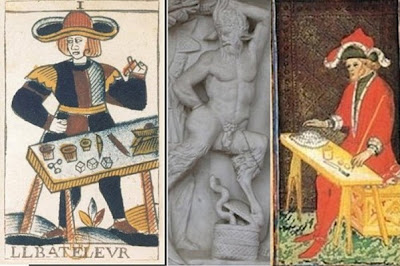
Both suggest the "virilia of Dionysus" (Clement of Alexandria's phrase) hidden in the chest, or the phallus on the tray in Roman friezes, as does the bush between the Bateleur's legs and his finger parallel to the object above it.
Now I want to turn to the left-hand jug in Titian's Bacchus and Ariadne
(http://www.cgfaonlineartmuseum.com/bellini/p-bellin15.htm). It is the jug on the far left of the painting, held by a satyr and steadied by Silenus. You are free to deny the comparison, but after all, it was a Dionysian painting done for Alfonso d'Este, with many exposed breasts, in the center a god putting his hand between a goddess's thighs, and on the far right a man with an erection looking down at a reclining goddess or nymph!
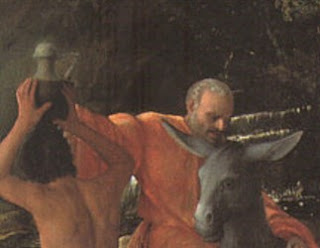
Compare it to the sacred "virilia" on the trays of Dionysian initiations, i.e.
(from http://www.bacchos.org/tarothtm/0et9mathermite2.html)

Be sure to notice who is carrying the tray, not only here but on the other sarcophagi a few paragraphs above. It is that same Silenus who Lorenzo described as fat and lumbering,so drunk as barely able to stay on his ass. In the myth he was Dionysus's teacher. On the sarcophagi, he is the initiation-leader in his mysteries.
Since the initiate is blindfolded, I suspect that the test here was for him to identify the objects on the tray by feel in mythical terms, having never actually seen them. Then when the veil is lifted he will perhaps see them face to face. Well, yes, it is not hard to do as Clement did, and make fun of such secrets. Perhaps one has to have been there.
Now let us turn from Greece to Egypt. In Egyptian-style imagery, it is the fact that the Bagatella card was number one, i.e. the chief god, or the one who begot the others, that would have been important, plus the broad-brimmed hat on the Sforza Bagatella (at right above), which the tarot of Paris and Marseille later favored (e.g. Noblet at left above). The Egyptian Zeus mentioned by Herodotus (http://perseus.mpiwg-berlin.mpg.de/GreekScience/hdtbk2.html, chapter 42) and worshiped by the "Ammonians", i.e. the followers of Ammon, had the horns of a ram. For Diodorus, this Ammon most likely merely had a ram-head shaped helmet (http://penelope.uchicago.edu/Thayer/E/Roman/Texts/Diodorus_Siculus/3E*.html, sec. 73).
Although at first glance it is perhaps not easy to see the hat in terms of horns, those of the Ammon-ram were unusual. When people of the Renaissance saw the "Bembine Tablet", an Egyptian-style artifact of ancient Rome. acquired by the famous humanist Pietro Bembo after the 1527 sack of Rome, they would have seen horizontal horns extending on both sides of the ram's head, and not only on them but on many other figures, no doubt in emulation of their chief or primal ancestor.
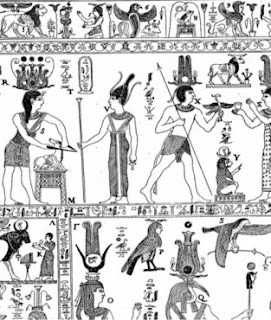
Such a ram, for readers of Herodotus and Diodorus, thus would have represented Ammon, whom Diodorus (sec. 68) identified as the father of Dionysus according to the Libyans. The Bembine Tablet image of the horizontal horns is thus another reason why the broad-brimmed hat versions of this card would have been favored by those wishing to project the Dionysian myths onto the card.
As early as the card for the Sforzas, 1450s, the design of the hats suggests the wavy horns of the god. The parallel is particularly striking when compared with an Egyptian relief that may or may not have been known at that time (it is from Aswan, at the first cataract, which marks the beginning of the Nile Valley. It is of Khnum, the god sacred to that place3 also the god who created human beings on his potter's wheel, although I doubt if that was been known in the 15th century.
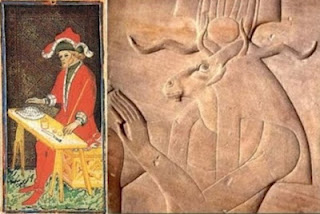
Other images of the god with the wavy horns were in the zodiacs at Dendera. These were Greco-Roman syntheses of the Greek zodiac signs and Egyptian images, in a temple that was above ground and accessible to any enterprising Egyptian (or possibly European traveler) who could get in and copy what he saw . The ram-god was Aries, first sign of the zodiac. The center one, with the curved horns, is another way that Ammon was represented in Egyptian temples. (These images come from French Egyptologist Christiane Desroche-Noblecourt's Le Fabuleux Heritage de l'Egypte, p. 311. The last one is incomplete, cut off by the edge of the page of her book).
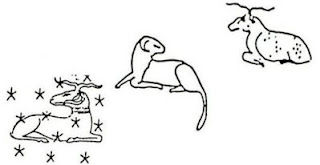
In Plutarch (On Isis and Osiris 12, http://thriceholy.net/Texts/Isis.html), the first magician, and the ancestor of at least Isis, was the deity Plutarch called the Egyptian Hermes. Plutarch relates that it was through a game that this Hermes played with the Moon goddess that the gods were able to descend into this world. As the father of Isis, he taught her his magic. Plato called him "Theuth" (Phaedrus 274d) and said he was the inventor of games and letters. As both hieroglyphs, a game, and possibly an instrument of magic, the tarot, with him on the first card, could easily have been credited to him as well. So the "Book of Thoth" (de Mellet 1781 and Etteilla 1785) potentially goes back to c. 1500.
The Bagatella's broad-brimmed hat might for some have associated him with Hermes, Thoth's Greek equivalent. In Cartari, 1647 edition (p. 165), Hermes' hat has horizontal wings sticking out on both sides, making his hat similar to the Bagatella's. This trickster-god Hermes is another exemplar for the small-time conjurer known as the Bagatella.
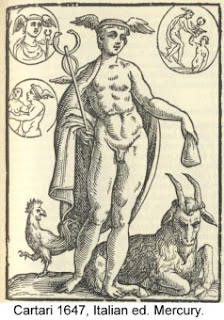
Hermes had the job, in the Greek stories about him, of escorting people to the land of the dead and also, as in the case of Orpheus and Eurydice, of bringing them back. Notice the stream between the Noblet Bateleur's legs, repeated in the "Chosson" of somewhat later. (The date for the "Chosson" might be 1672, based on the date on tits Two of Coins, which also has the name "Chosson"; but since that particular cardmaker wasn't in business then, it might well be early 18th century; or else the design was initiated by someone else. I will refer to it as the "Chosson" of the late 17th or early 18th century.) In classical literature, there was the River Styx separating our world from Tartarus. In Dante's Divine Comedy, streams were also at the boundary between Purgatory and Paradise. In Renaissance art, likewise, streams also represented the separation from this world and the next. For example, in Bosch's Wayfarer, c, the main figure faces a rickety bridge over a stream.
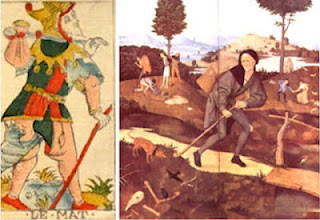
With his staff, already present in the card for the Sforzas in the 1450s, the dog, already in the Tarot of Mantegna Misero (both below, first image), and his pack, added in the Cary Sheet card (below left, second image), he suggest the tarot Matto, on the "fool's journey" through life to the hereafter.
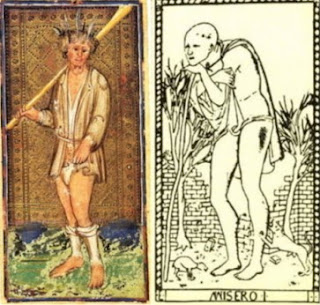
The Cary Sheet Bagatella is worth recalling again for his three-tiered hat. Like the Cary Sheet Matto, he recalls that other Egyptian Hermes, another follower of Isis's magic, Hermes Trismegistus, the thrice-great.
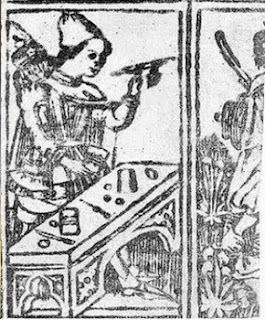
One final association to the Bagatella is to Dionysus's son by Venus, the god Priapus. We have already met him in the Bellini's Feast of the Gods for Alfonso d'Este, as the one who hides a perpetual erection in the folds of his robe, also the figwood scarecrow god of the Priapus poems. Here is the way he is portrayed in Cartari 1647 (p. 230).
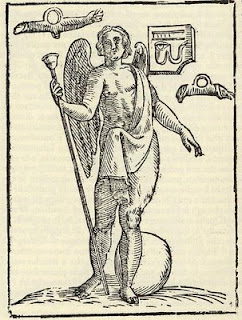
The Magician's wand bears some resemblance; and in the Noblet there is again the phallic finger, paralleling the phallic knife (at left below) and perhaps referring also to the plant between his legs. The small amulet, identifiable by the hole in which a string would have been passed to make a necklace, is another representation of his distinguishing feature. Such amulets were still used in 15th-16th century Europe, for example the one below right found in Bosch's hometown of 'Hertogenbosch (image taken from Laura Dixon, Bosch p. 231).
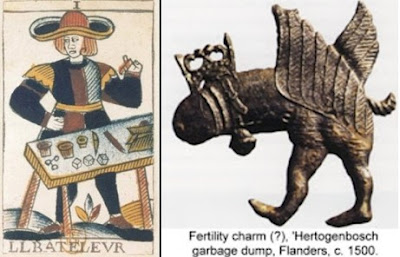
B2 - B5: IMPERATRICE, IMPERATORE, PAPESSA, PAPA
B2: Imperatrice
The card we know as the Empress was always the Imperatrice in Italy. In the early lists from Northeastern Italy she follows the Bagatella. On the early cards (e.g. the Cary Sheet, c. 1500), she holds the shield of Empire, symbol of the succession, on her lap, like a Madonna and Child. More to the point, she is like Isis with the infant Horus, as seen on Roman coins, e.g. at left below. All the nobles collected ancient coins, including the Estensi. Roberto Weiss, in The Renaissance Discovery of Classical Antiquity, p. 171:
§ «It is scarcely surprising in view of the prevailing enthusiasm, that the discovery of a hoard of ancient coins aroused considerable interest. ... It was therefore only natural that having learnt in 1494 that a peasant had unearthed some Roman coins near Reggio Emilia, Matteo Maria Boardo should have hastened to inform his master, the Duke of Ferrara (footnote: Matteo Maria Boiardo, Opera vulgari, ed. P. V. Mengaldo (Bari 1962), 275)» §
On the same page Weiss cites a letter from Giorgio da Negroponte May 19 1507 to Isabella d'Este "in which he emphasized the difficulty in securing ancient Roman coins owing to the great demand for them", in Weiss's words.
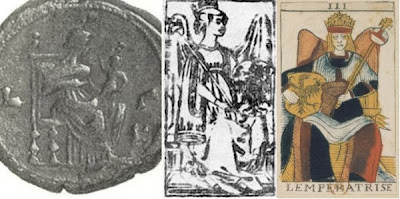
The drapery behind the Cary Sheet Empress gives her the suggestion of wings, continued in the "Marseille design of the Noblet, where there is even what might be the suggestion, on the lower right of the chair, of a wing.
Isis, in Plutarch Isis and Osiris16, took the form of a swallow. To me the drapery looks more like a vulture's wings. That would identify the Empress with nature, and so indirectly with Isis. Leon Alberti says, in his treatise on architecture (1470 but written earlier), "The Egyptians employed the following sign language: a god was represented by an eye, nature by a vulture..." His source was a text by the Roman general Ammianus. Isis, in turn, was a major personification of nature. This idea has been developed at length by Hadot in his The Veil of isis: An Essay on the History of the Idea of Nature (in Google books). Fior one thing, there was the famous statue supposedly of Isis at Sais reported by Plutarch, Isis and Osiris 9, with the motto ""I am all that hath been, and is, and shall be; and my veil no mortal has hitherto raised". There was also Apuleius, whose Isis tell this protagonis Lucius, "I come to you - I, natural mother of all life, the mistress of all the elements" (Lindsay trans. p. 237). Later her devotees praise her as "Mother of the Stars, the Producer of the Seasons" (p. 239). There was also the Roman philosopher Macrobius said (Saturnalia I, 20, 18):
§ «Isis is the earth or beneath the sun. This is why the goddess's entire body bristles with a multitude of breasts placed close to one another [as in the case of Artemis of Ephesis], because all things are nourished by earth or by nature» §
Finally, both the Hypnerotamachia (Strife of Love in a Dream), of 1499 Venice, and Ripa's Iconologia, of 1603 Rome, associated nature with the vulture. The Hypneromachia has for its second image an altar with 'on its face, the images of an eye and a vulture" (Godwin translation, p. 41). The second phrase of the "translation" of this artfully constructed series reads "...to the god of nature..." Below I have reproduced the first line of the hieroglyphs and put under it the first line of what the novel says is their translation into Latin. The first hieroglyph is translated as "from your labors"; the second is "god of nature" followed by "freely" and "sacrifice" (the urn). The word order, is that of ordinary Latin.
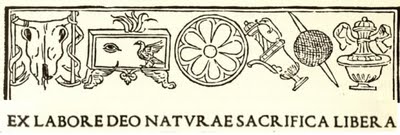
Ripa's image of nature (Nova Iconologia, Padua 1611 edition, image 222) is of a naked woman holding a bird. It is on her left side, like the Empress's shield.
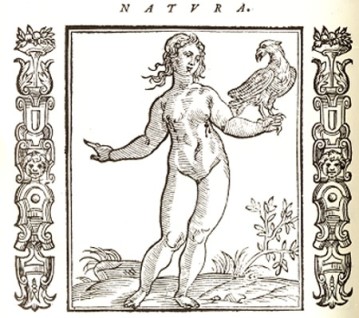
Ripa says, in the first English translation:
§ «She is naked, to denote the Principle of Nature, that is active or Form, and passive or Matter. The turgid Breasts denote the Form, because it maintains created Things; the Vultur, a ravenous Fowl, the Matter; which being alter'd and moved by the Form, destroys all corruptible Bodies.
(http://emblem.libraries.psu.edu/Ripa/Images/ripa056a.htm)» §
In such manner the vulture is associated with nature, and thence to Isis, Hadot hypothesizes, and I agree.
Nature in these presentations, with its "multitude" of "turgid breasts", is a divine mother. It is perhaps worth noting that around the time of the Cary Sheet, Leonardo da Vinci dreamed of a "nibbio", a small vulture, which Freud analyzed as a mother-figure.
An example of how the madonna and child image becomes detached from its Christian use is shown by another such mother and child in the Hypnerotomachia, there a representation of Venus as the goddess of a female cult of Venus, in this case Venus suckling the infant Cupid.
For another such identification, we may turn again to Apuleius in The Golden Ass: along with everything else, Isis tells the protagonist Lucius and tells him, "The Cyprians in their island home call me Paphian Venus" (Lindsay trans. p. 237). Correspondingly, the picture in the Hypnerotomachia could just as well be of a cult of Isis; the imagery is the same as on the Roman coin shown above, or any Christian Madonna and Child.
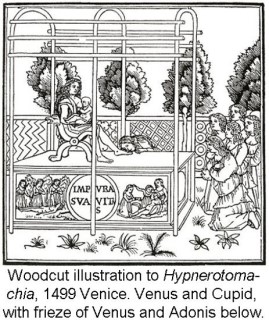
Other candidates for the Empress are Dionysus's mothers, any of them: Semele, Persephone, Demeter--or the Libyan maiden Amaltheia (Diodorus sect. 68), whom in the Libyan myth his father Ammon made queen of that area after siring Dionysus from her. In Semele's case the shield on the lap would connote Dionysus in her womb, as she died before she could give birth.
B3: Imperatore
With the Emperor, there is again the shield, symbolizing the continuity of the Empire as represented by his fertility. He could be Osiris, husband of Isis and father of Horus. He could also be Dionysus as statesman, in his bearded persona. Daimonax has pointed out how the Emperor's helmet corresponds to Dionysus's hair on one Roman relief :
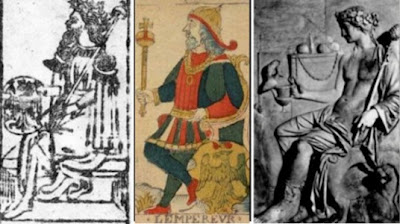
As I have already said, the date for the card in the middle above might be 1672, based on the date on the Two of Coins, together with the name "Chosson"; but since that particular cardmaker wasn't in business then, it might well be early 18th century; or the design was initiated by someone else.
The Emperor could also be any of Dionysus's fathers, as listed by Cicero and Diodorus (except those with rams' heads, of course), but especially Zeus. Beanu on Aeclectic once pointed out the resemblance of the c. 1650 Noblet to a particular Zeus, that of his colossal statue at Olympia as described by Pausanias. This text was available in Greek in the 15th century. It is also mentioned in Plutarch's Lives, life of Aemilius Paulus, which was available in Latin. Except for the lack of a helmet, the 16th century rendering below (http://en.wikipedia.org/wiki/Statue_of_Zeus_at_Olympia) is much like the "Marseille" image of the card:
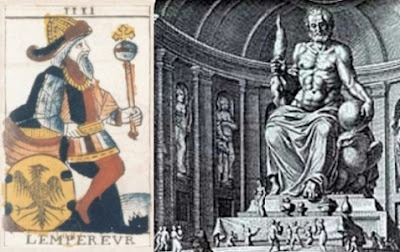
This would be an example of the card's imagery changing to fit the Dionysian myth. The body of water on the lower right of the card might be the Nile, corresponding to Osiris, or the river on which the "Olympian Zeus" in Athens stood, as Plato recounts at the beginning of the Phaedrus
(http://academic.brooklyn.cuny.edu/classics/jvsickle/mpPhaed.htm).
B4: Papessa
The Popess corresponds to the High Priestess of the Maenads or female Bacchantes. Negatively, she is the deluded Agive, Queen of Thebes, in Euripides' Bacchae, who eats raw flesh including that of her own son, thinking it that of a wild animal. Positively there is Dionysus's wife Ariadne. In another myth, available in Latin in Ovid's Metamorphoses (http://www.theoi.com/Text/OvidMetamorphoses8.html, paragraph 169),she knew the secret of the Cretan Labyrinth; as such, and as the daughter of the king, she would have been a High Priestess. On Roman-era Dionysian reliefs, there is sometimes a female initiation leader, e.g.:
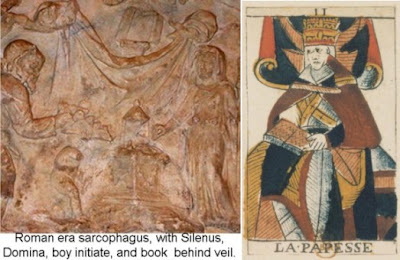
In this relief there is a book behind a curtain, a book of secrets; the Popess is always portrayed with a book, and by Noblet c. 1650 (at right above) with a curtain behind her (image and observations are from Daimonax at http://www.bacchos.org/tarothtm/5pape1.html).
In the Osiris myth, the Popess corresponds again to Isis, who would have been taught magic by her father "Hermes" (Plutarch sec. 12). On sculptures of her, e.g. in the Villa Adriana, there were the crossed straps of the later Popess (seen also on "Pope Joan" and also depictions of the popes); the illustrations to Cartari (at right below) popularized this image of Isis:
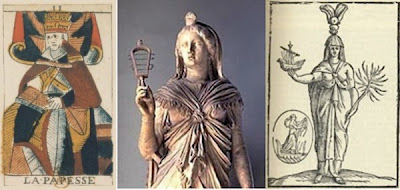
Robert O'Neill has pointed out the resemblance between the Cary Sheet Popess and the figure of Isis in the Borgia apartments at the Vatican, done around the same time. When the image is reversed, to make it as it was for the carver, the resemblance is close.
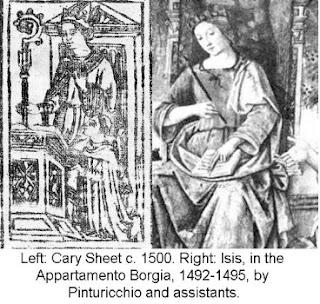
I would explain the acolyte as a reference to Pope Joan's lover, by whom in the legend, as recounted by Boccaccio,De Claris Mulieribus (Praise of Famous Women), she betrayed herself giving birth. Not everything is Egyptian. The bishop's staff is found on several Popess cards, e.g. the Noblet of c. 1650 (http://www.tarot-history.com/Jean-Noblet/pages/le-pape.html).
In the Hypnerotomachia of 1499 Venice, a very Popess-like High Priestess is depicted, there identified as the head of a cult of Venus. Venus was identified by Apuleius with Isis, as I have already remarked:
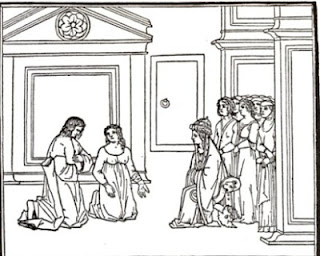
B5: Papa
The tarot Pope is again Dionysus, the older, bearded one, now as head of his cult. Or he is Tharopes, to whom Dionysus taught the cult, according to Diodorus. Or Silenus, the older bearded male initiator as seen on sarcophagi (e.g. the one shown above, in connection with the Popess) and elsewhere. Or he is one of the wise priests of the cult of Osiris described in Apuleius Golden Ass Book 11. I will say more about the later versions of this card, with pictures, in section B19 of this essay.
Renaissance artists had fun depicting the drunk Dionysus or Silenus. Card players would have had fun, too, comparing the Pope to these stock figures. So, I imagine, did the Belgian cardmaker who, probably advised not to depict the Pope in this Catholic stronghold, substituted a depiction of Bacchus.
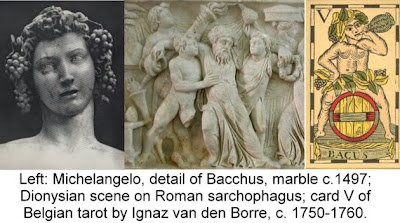
B6 - B9: AMORE, CARRO TRIOMPHALE, RUOTA, VECCHIO
For the rest of the cards before Death at 13, there are numerous variations. I am going to discuss the so-called "virtue" cards as one group (even though Justice was typically number 19 or 20 in the early lists) and the other cards before 13 as another group. I am going to discuss that second group first, since it presents the circumstances for the exercise of the "virtue" group. However I am going to discuss the card before Death, namely the Hanged Man, together in another group with Death because I think the two go together.
B6: Amore
On the early lists, the name was Amore, Love. It apparently became The Lover, L'Amoureux, in France, I cannot find pre-19th century cards with the plural, "Lovers". Nonetheless, in a Dionysian interpretation, the Love card is the marriage, or at least the love-at-first-sight meeting, of Dionysis and Ariadne, with his friend Cupid hovering overhead. From the early 18th century, there is actually a painting of this scene that looks very much like the Marseille II version of the card, with the older woman on the left as a Bacchante: (Again, the "Chosson" might not be 1672, or not originally by Chosson).
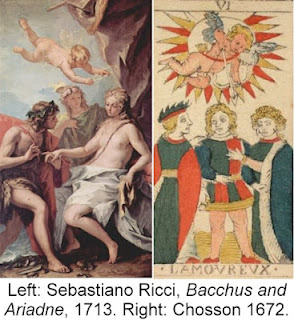
Alternatively, the card might be showing two candidates for initiation, male and female, being addressed by a female initiation leader. It might be as in Mozart's Magic Flute, where the two are destined to marry. Mystically, that could be the achievement of godlike androgyny, as depicted in alchemy.
The young man and the young woman are initiates enacting a sacred Dionysian drama; we were introduced to them in the previous card, where they were the acolytes taking an oath before the initiation-master. The older woman wearing the wreath is the Domina, the female initiator on the Dionysian sarcophagi. And there is another initiator, above them: Cupid, the Greek Eros. He is Dionysus, too. The Orphics identified Phanes, the first incarnation of Dionysus, with this Eros (http://www.sacred-texts.com/cla/af/af10.htm):
First (I have sung) the vast necessity of ancient Chaos,
And Cronus, who in the boundless tracts brought forth
The Ether, and the splendid and glorious
Eros of a two-fold nature,
The illustrious father of night, existing from eternity.
Whom men call Phanes...
Phanes is Greek for "light-bringer", a suitable epithet for who is the center of intense rays of light. Dionysus as Eros is the instigator of love and passion. With his "two-fold nature", he represents the goal, the merger of the two into one, and also its product the child. Dionysus's wine is the lubricator of procreation. Cartari says that the ancients called Priapus the son of Venus and Dionysus because sexual love results from the combination of beauty and wine; however this function is also one that Dionysus himself serves. Cartari quotes a familiar saying that Venus can do nothing without Bacchus.
There is also the Roman dramatist Terence: Sine Cerere et Baccho friget Venus, Without Ceres (bread) and Bacchus (wine) Venus (love) freezes (http://en.wikiquote.org/wiki/Terence).
From the perspective of Dionysus as Osiris, another interpretation is possible: the marriage of Isis and Osiris, with their unborn son Horus on top, whom Plutarch called Apollo (hence the sunburst) and said was conceived and born even while his parents were in their mother the Moon's womb (Of Isis and Osiris XII, at
http://thriceholy.net/Texts/Isis.html).
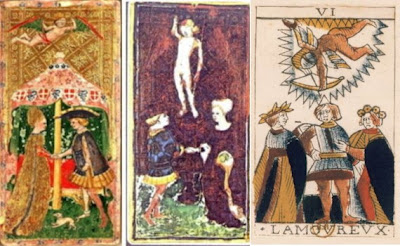
The descended Horus, Horus the child, the Greeks called Harpocrates. As the child of Osiris/Dionysus, they identified him with Priapus, as we can see from the passage below in Cartari, Lyon 1581
(http://www.uni-mannheim.de/mateo/camenaref/cartari/cartari1/te06.html). Priapus was the offspring of Venus and Dionysus. With his perpetual swollen member, he is an apt Egyptian version of the lower Cupid. The winged Horus would then be the celestial Cupid, in the exposition favored by Renaissance painters and humanists such as Equicola (see previous section on Plato and Ficino for more).
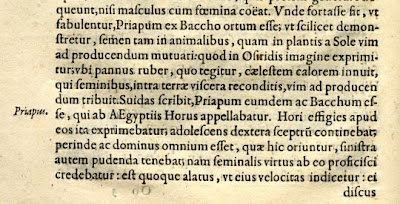
By his finger to the mouth, Harpocrates commended the virtue of silence, which is good for both the upper and lower mysteries of Bacchus and Venus. Below he appears in Cartari 1581 with his parents, Osiris as the all-seeing Sun and Isis, according to Cartari (p. 249-250 of the 1581, and the caption to the woodcut in the1647), as Angerona, goddess of the returning sun. Harpocrates' birthday was celebrated at the Winter Solstice, one of several precursors to Christ whose feast days Christianity co-opted.
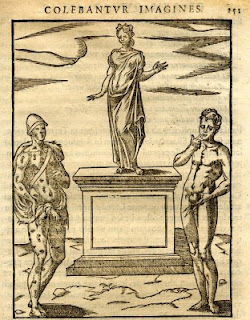
The illustration did not use the device of the fold in the robe that we see in the d'Este paintings of Priapus. The 1647 version of this illustration gets around this issue by showing Carpocrates as a very Cupid-like little boy, even with wings; perhaps there is something in the text about his connection to the upper Horus, by then known as a hawk-god.
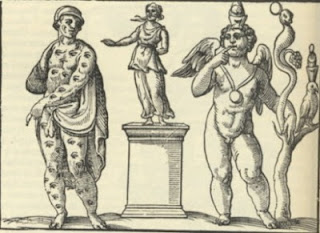
There are some hand gestures in the Chosson/Conver image that suggest an identification of the young man in the Lover card with the lower Cupid (Daimonax points them out in his discussion of the card).
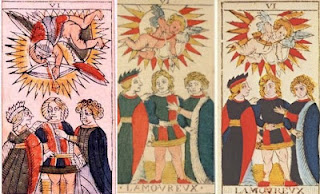
In the Dodal of c. 1701, the young man hand points in the direction of his crotch. In the "Chosson" and Conver, it is the older woman's hand that does so, as though to say to him that marriage is about procreation. Meanwhile, the young woman has her hand on the young man's heart, indicating that for her the issue is love. In the two other cards, she has her hand in front of her belly. This is either to point to her womb (perhaps she is already pregnant) or a defensive gesture, that her love is chaste. Card players would have had fun with these gestures.
The earlier tarot Love cards have the lovers looking at each other and not some third party. This is also true for Titian's Bacchus and Ariadne: they look upon each other with transfixed gaze. Likewise Lorenzo de' Medici's carnival song opens:
Quest'è Bacco ed Arïanna, Here are Bacchus and Ariadne,
belli, e l'un de l'altro ardenti: Handsome, and burning for each other:
perché 'l tempo fugge e inganna, Because time flees and fools,
sempre insieme stan contenti. They stay together always content.
It is the lovers' union that is important: not only does one live in the other, as Erasmus characterized love, but the other lives in the one, even as God lives in his people.
Another important feature, among the early cards only in Milan, and then later in Noblet only, is that Cupid is blindfolded. This again is true to the Renaissance, as represented, for example, by Pico della Mirandola. One meaning of the blindfold is that when Cupid strikes, reason and good sense go out the window. But the Renaissance philosophy of Pico della Mirandolla kept the blindfold for another reason: Love is blind "because he is above the intellect" (Wind, Pagan Mysteries of the Renaissance p. 54). The divine love here is that extolled by Plato, the love of God, the "joy above understanding" (Wind p. 56), to be experienced on the wings of Dialectic, i.e. the identification and transcending of contradictions.
For Pico and Ficino, as for Renaissance thinkers of many persuasions, it was by the union of the opposites (Nicholas of Cusa called it "the coincidence of opposites")--hence the "two-fold nature" of Eros in the Orphic quote--among them the male and the female, that one ascends the ladder toward God and a love beyond the capacity of the mind to grasp. When Pico spoke of a blind Cupid, he was consciously echoing a line from an Orphic hymn quoted by the Roman-era philosopher Proclus: "...in his breast guarding eyeless swift love" (Wind p. 57). For Proclus and Pico alike, "blind Amor" was an Orphic phrase for the love beyond intellect.
In the Marseille versions of the card, the two younger figures aren't looking at each other but at a third, older person. One interpretation is that the card is one where the young man has to choose between between virtue, with a laurel wreath, and pleasure, decked with flowers. Depictions of "Hercules at the crossroads", based on a story attributed to Socrates by the Greek philosopher Xenophon, were common in the Renaissance, But such a choice hardly fits the Dionysian/Platonic interpretation of Socrates; for whom there are only lower and higher pleasures, and an ascent from one to the other.
In this vein, as early as 1498 Albrecht Durer did an etching, which he called simply "Hercules" (below), in which the figure of Virtue is about to club the recumbent Pleasure. Hercules blocks Virtue's swing with his cudgel. It is as if to say that Virtue need not oppose Pleasure, that the two can co-exist. The two ladies here are similar to two portraits Durer did at that time, of the same young woman, once as Piety and the other as Voluptas, Joy. They are the two aspects which when combined made a young woman attractive as a mate, as Panofsky observed (Durer, p. 41 and figs. 67, 68).
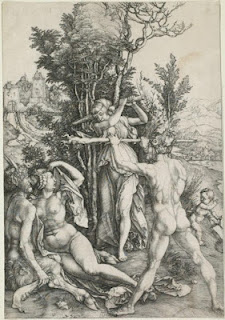
Wind (p. 85f) relates that in 1618 the playwright Ben Jonson put on a masque for James I called "The Reconciliation of Virtue and Pleasure". Published in 1640, it made the point that even so-called lower pleasures such as dancing--which the English Puritans opposed--are not necessarily opposed to virtue: some dances even promote virtue--e.g. the ones in Jonson's masque. What is noble should be sweet", Jonson said. Yet the two poles are not equal: "Pleasure the servant, Virtue looking on", he concludes. Virtue must be in command.
So perhaps on the Marseille version the young man is looking at the older woman for approval, and so is the young woman. Is their love virtuous? That is a question implicit in the Dionysus myth as well. His love for Nicea was not virtuous, since he took her asleep. But Ariadne, in the version of the myth represented by Titian and other painters, met his love with her own, and both rose to the stars.
On the Marseille card, the young woman has her hand to the young man's heart, as though to say that the pleasure she offers is of a loftier kind than mere sensuous enjoyment: her love is of the heart. The older one looks at both young people with a kindly expression: she is not Pleasure's rival at all. Virtue blesses the union of the young man with the mate of his heart.
B7: Carro Triomphale
The Carro Triumphale, or Chariot, is Dionysus in his victory parade, the so-called "Triumph" which he was said to have invented. He is often shown in a chariot, usually pulled by centaurs. The victory hymn was called the "'Thriambos", from which the word "Triumph" derives (at least according to my Webster's New World Dictionary, 1967 edition). Not only that, but the first celebratory procession after military victories abroad was, according to Diodorus and others, that of Dionysus returning from India, as I have already discussed.
Otherwise, the card is of interest for reflecting the chariot of the soul in Plato's Phaedrus, in which first the dark horse leads the chariot to the experience of desire, and then its restraint by the light horse leads the chariot upwards toward the divine frenzy. The Phaedrus is nothing if not a Dionysian tract, in its philosophical phase.
Here is how Plato describes the souls of gods and humans as charioteers (http://classics.mit.edu/Plato/phaedrus.1b.txt):
§ «...Now the winged horses and the charioteers of the gods are all of them noble and of noble descent, but those of other races are mixed: the human charioteer drives his in a pair; and one of them is noble and of noble breed, and the other is ignoble and of ignoble breed; and the driving of them of necessity gives a great deal of trouble to him... (1)» §
In the case of the Sforza (PMB) card (at left below), both horses have wings, go the same way and have the same color. The lady on the chariot must be one of Plato's goddesses, who rode their chariots in the highest part of the circuit of heaven. She is Chastity or Temperance, most likely, or some other virtue.
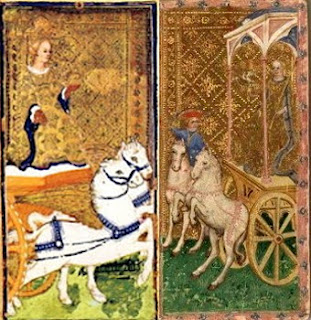
In the earlier Cary-Yale card (at right above), on the other hand, a groom is actually on top of one horse. That one has all four feet on the ground; that is Plato's horse of honor. The other has no human guide and is rearing its front feet, as though to charge ahead on its own initiative. It is the ignoble horse, the one that gives the charioteer a lot of trouble. The charioteer is actually the one on the horse, not the one on the chariot. So he is controlling his ignoble side by directing his noble side by reason. Later Chariot cards emphasized the two contrasting horses by giving them two colors, one light (whitish) and one dark (reddish). An example very close in time to the CY and PMB is the Chariot card from a Ferrara deck of c. 1450 (below left) that probably goes with two other trumps in Warsaw. A later example is the Catelin Geoffrey card of 1557 (below right), which like the Cary-Yale has a groom holding the noble horse, while replacing the woman with an older man. The groom is on the other side as compared with the Cary-Yale, but since the horses have also switched sides that makes no difference.
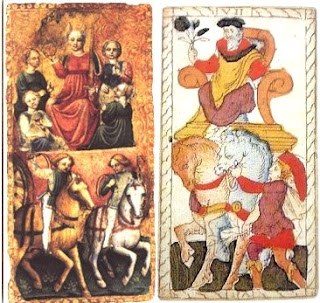
Here is what Plato says about the two horses later in his story:
§ «The right-hand horse is upright and cleanly made: he has a lofty neck and an aquiline nose: his colour is white, and his eyes dark; he is a lover of honour and modesty and temperance, and the follower of true glory; he needs no touch of the whip, but is guided by word and admonition only. The other is a crooked lumbering animal, put together anyhow; he has a short thick neck; he is flat-faced and of a dark colour, with grey eyes and blood-red complexion; the mate of insolence and pride, shag-eared and deaf, hardly yielding to whip and spur» §
This passage gives us an idea why in the Marseille version (below) there are no reins. The first horse responds to the words of the charioteer. The second horse is controlled by the first (although in Plato reins are in fact needed, for the unruly horse can be controlled only by the most concerted effort of both the other horse and the charioteer's pulling of the bit in its mouth).
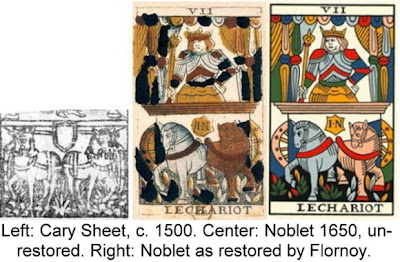
In the Cary Sheet, it may be that the card was not colored. So the two horses are distinguished by their body positions. The head of the one on our left, the charioteer's right, goes in the direction of the other horse but its feet go the other way: the head follows reason, but the body does otherwise.
Noblet continues the body positions of the Cary Sheet, but reverses the direction that the horses look. Plato says that the noble horse is on the "better" side, which would be on the right. Noblet is seeing the horses from the perspective of the charioteer. He follows the Warsaw card and Catelin Geoffrey in making the horses different colors, reddish and whitish. In restoring the card, Flornoy got the colors more or less right; however in the original, the reddish horse seems to me the darker of the two.
What then of the charioteer himself? Plato says he is the part of the soul that stands high enough up so that once he could see absolute Goodness, Beauty, etc., but now only discerns them dimly when he sees their imperfect copies in the material world, though a hazy recollection of his life before entering matter. He "sees through a glass dimly", the Jowett translation has it. Actually, the Greek is not so close to St. Paul's wording, although the sense is similar: he sees through darkened organs of perception.
Neither horse has wings. Yet at the sight of Beauty, they start to grow back, as painfully as if they were new teeth. If the unruly horse has its way, then the horses are in danger of losing their wings for the next 9000 years. It depends on the strength of the charioteer--Plato has a vivid description of his effort reining in the unruly horse. That both horses are growing wings means that both are impulses toward the divine. But such impulses can go wrong without proper guidance. Only the strongest and most alert effort of will, in our card represented by the charioteer and the noble horse, can give the unruly horse a "holy fear", so that the chariot is directed well. Then both horses will move in the direction of the noble horse, as is starting to happen in the card.
The situation is similar to that of the Lover card, when the older lady is interpreted as Virtue and the younger as Pleasure. Both are needed to lead the soul upward. But it is as Ben Jonson said: "Pleasure the servant, Virtue looking on".
All this is in accord with Christian Neoplatonism. Divine beauty is none other than God, whom we must not try to be at one with through excessive zeal but approach in holy fear as well as desire, with no care for life, possessions, or other considerations of ordinary prudence, but with a respect born of fear. It is exactly such respect for Virtue that will be needed in the trials to come.
In the 1760-61 Conver version of the card (below), the horses are regrettably the same color. However Conver has made some effort to convey the meaning, in that the charioteer wears epaulettes that look like the masks of tragedy and comedy: the one being the sorry road of unmastered passion and the other the happy road of virtue's triumph (as in "Divine Comedy"). The two are not very clear, but the two masks, put side by side to represent drama as a whole, was seen everywhere. Camoin and Jodorowsky differentiated them in their "restoration" (with much interpretation as well) of 1999.
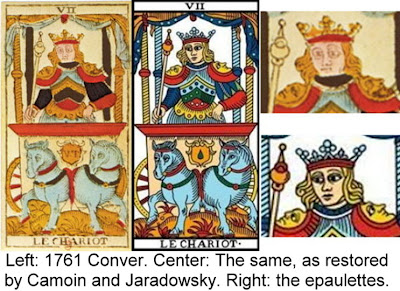
For Renaissance Platonists reading their Plutarch, it might have seemed that Plato had selectively borrowed the horses' colors from Egypt. For Plutarch (Of Isis and Osiris 22) says that red was the color of Seth, the god of disorder and suffering, while white was the color of Horus, son of Osiris and representing right order.(The part where he says that black was the color of Osiris must be selectively disregarded.) The struggle between the two horses is the epic battle between Seth and Horus for the throne of Egypt. And just as both horses are needed for things to go right, so in Plutarch's account, on Isis's orders Seth is not killed but only mastered. Such is the world, and as it should be, as Plutarch says in section 45:
§ «For the harmony of the universe is reciprocal, like that of a lyre or bow, according to Heraclitus, and according to Euripides:—
“Evil and good cannot occur apart;
There is a mixture to make all go well”» §
For without evil, there is no virtue, merely the habit of doing things in a certain way. And without disorder and opposition, there is no need for the creativity needed to surmount the opposites and ascend the ladder.
B8: Ruota
Early lists mostly have the Wheel before the Old Man; but sometimes it was the other way around (see "archaic orderings" at http://l-pollett.tripod.com/cards26.htm). It doesn't make much difference. She is. blindfolded in the PMB's Sforza card of the 1450s (center below), to signify that she strikes out at random, who strips us of our materiality and puts us in the position of the Vecchio, later called the Hermit.
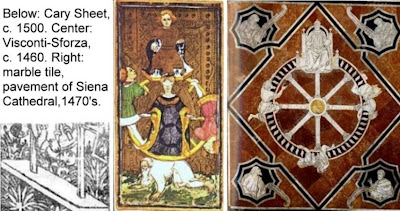
The Wheel of Fortune is a traditional Greco-Roman symbol, symbolizing the buffets of fate. I think it is significant that in the Cary Sheet the man at the bottom still is on the wheel, hoping for another rise upward. In that way he is like the man on the bottom of the Wheel in the marble pavement of Siena Cathedral
The card-designers could have read about the Wheel in Clement of Alexandria, who in a chapter on symbolism speaks of a "Wheel that is turned around in the precincts of the gods and that was derived from the Egyptians". For clarification, there was also Hero of Alexander, who said, "In Egyptian sanctuaries there are Wheels of bronze against the door-posts, and they are movable so that those who enter them may set them in motion, because of the belief that bronze purifies". Also, Proclus spoke of the Orphic "Wheel of birth" in the same context, which leads to purification. Since the Greek writers attributed the doctrine of reincarnation to the Egyptians, the card-designers would have assumed, with them, that the wheel in Egypt symbolized purification through successive incarnations. (I get these quotes from Jane Ellen Harrison, Prolegomena to the Study of Greek Religion, p. 591f. More from Proclus is in Thomas McEvilley, The Shape of Ancient Thought... - Google Books Result, p. 145.)
There is a suggestion of at least an arc, like that of the sun, from birth to death, and ascent/descent, in Noblet's version of the card (below, where Noblet's restoration makes the blue in the original clearer). There is water at the bottom on both sides, as though the ascending figure has come from it and the descending figure returns to it.
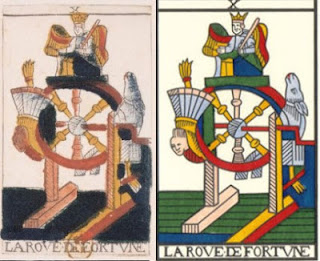
The Sphinx-like little king at the top of the wheel is an Egyptian image: Egyptian sphinxes, as opposed to Greek ones, were representations of the Pharaoh with the body of a lion, as the Greek authors on Egypt recorded. Yet perhaps the card makers attached the Greek meaning to them, derived from the famous story of Oedipus. The Sphinx, with her simple riddle, lured him into becoming King of Thebes and marrying its Queen. He thought he was clever, outwitting the oracle that had predicted he would kill his father and marry his mother. Yet the Queen of Thebes was in fact Oedipus's mother, and the reason she was a widow was that Oedipus had unwittingly killed her husband, Oedipus's father. The Sphinx at the top of the wheel suggests that "pride goeth before a fall", as they say, and that the future is out of one's hands.
In tragedy, part of the Greek theatre of which Dionysus was the patron, there was the rise and fall of flawed heroes; in comedy, there was the suffering of the outcast who is restored to grace in the end. The sphinx-like king at the top of the Wheel in the "Marseill" designs might be a nod to the tragedy in which the sphinx both raises him up, as he gets the kingship of Thebes by answering its riddle, and brings him down, in that he thereby marries his mother.
In the Osiris myth we have his wise reign, then his treacherous murder, and finally his eventual triumph, through his son in this world and by his own and his wife's merit in the next. That is a cycle that ends happily, like that of Christian salvation.
For Dionysus, there is a cyclical development through incarnations: he is born as the child of Zeus, yet is dismembered by the Titans. He is conceived again, and Hera takes away his mother. Then Hera inflicts him with madness. He triumphs in India and again in Thebes. He wants to marry Nicea, and even violates her while in a drugged sleep, but she kills herself. He marries, but his wife, and in some accounts he himself, is killed by Perseus in his reckless attack on Argos (I will give the Roman-era references when discussing the Tower card). He descends to Hades but eventually rises to Olympus.
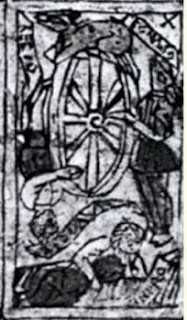
In some early cards, such as the 15th-16th century Italian one in black and white above, the initiates are shown wiser going down than up, as shown by which part is human. The same was true in many depictions of the Wheel outside of the cards. Andrea (http://www.letarot.it/page.aspx?id=122) quotes from the early 16th century poet Ariosto, in his Satires (VII, 46-54) on this point:
§ «Quella ruota dipinta mi sgomenta / ch’ogni mastro di carte a un modo finge: / tanta concordia non credo io che menta. / Quel che le siede in cima si dipinge / uno asinello: ognun lo enigma intende, / senza che chiami a interpretarlo Sfinge. / Vi si vede anco che ciascun che ascende / comincia a inasinir, le prime membre, e resta umano quel che a dietro pende”
(That painted wheel dismays me / that every card maker paints in the same way: / I don’t think I like seeing so much harmony. / What is set painted on its top / is a little donkey: everyone understands the enigma, / without calling a Sphinx to interpret it. / We can also see that everyone who ascends / starts to become a donkey, and what stays back and leans it is the human side)» §
The Sphinx, which perhaps even then sometimes replaced the donkey at the top (or why would he mention it?), in this way is an agent of the divine, evil serving good.
There is an Orphic medallion that contains iconic elements seen in all three of the preceding cards, Love, Chariot, and Wheel. I show it below together with another Chariot card, Northern Italian, that I haven't shown yet. It is one of those cards found in the Sforza Castle and estimated to be c. 1600.
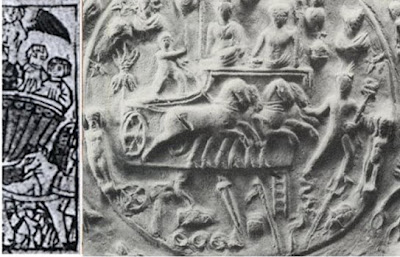
Most obvious on the medallion--and on the card as well--is the chariot, with what I think is a male and female riders, whom I suspect are Dionysus and Ariadne on the medallion. As in many of the early cards, the horses have a groom; I am not sure, but I think there is a horse on the card with a rider. In the medallion the groom is Mercury, god of intelligence and also guide of souls in the afterlife. The driver, urging the horses on, is Eros, Desire in the Platonic sense of that which leads us toward Beauty and the other divine archetypes. He would also seem to be the charioteer on the card as well, holding his flag; or is it a wing attached to his back? Besides these elements, there is the wheel below them, the Orphic wheel of fate. And there is the ladder of ascent, from one level to the next. The medallion is very ancient; as it has on it only 11 signs of the zodiac, for at one time Scorpio took up two months, and the Balance, the only non-animal sign of the zodiac, wasn't yet there. But given the close similarity between the Sforza Castle card and the medallion, it is my strong surmise that it was known in 16th century Italy.
B9: Vecchio
In most of the early cards, the Vecchio, or Old Man, is an old man on crutches, modeled on representations of Petrarch's Triumph of Time (at left below). But in the PMB card he gets a lantern (at right). That makes him more the one shining the light of truth in the darkness. His prototype may have been Diogenes, who had carried a lantern in the middle of the day and said he was looking for an honest man. Or it might have been one of those old hermits who spent their days meditating and having visions in the desert, like St. Anthony, frequently depicted in the Renaissance with his visions of demons.
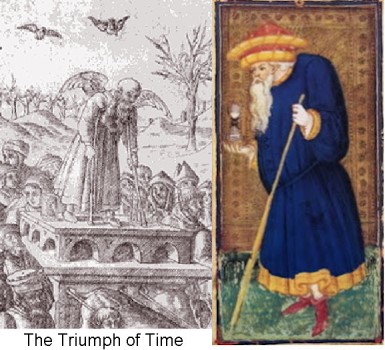
He might have also been seen in terms of the Grail hermit Trevizent. Grail stories were popular then; the same workshop that did the PMB probably did a series of Grail Legend illustrations of around that time and place, judging from the style (Kaplan Encyclopedia of TarotVol. 2 pp. 162, 164; to view, see
http://forum.tarothistory.com/viewtopic.php?f=11&t=365&start=10#p4604 and
http://www.tarotforum.net/showthread.php?p=1998820).
Also, Pisanello in 1440 had decorated the castle at Mantua with a whole series of Grail Legend illustrations (http://www.thais.it/speciali/PISANELLO/Pisanello.htm).
In both the French (by Chretien) and German (by Wolfram) versions of the story
(http://en.wikipedia.org/wiki/Perceval,_the_Story_of_the_Grail, and
http://en.wikipedia.org/wiki/Parzival),
the hero Parsifal/Parzival meets an old hermit who tells Parsifal/Parzival what he needs to know after he has been disgraced by a "loathsome damsel" at Arthur's court. The damsel (named Cundrie, in Wolfram) had said he failed to do what had been required of him at the Grail Castle, that of asking the proper question. Instead, he followed the advice of his previous mentor and kept quiet when in the presence of people he didn't know. Earlier he had been mostly impressed by knights in shining armor. Then, with this turn of Fortune, he is willing to listen to someone dressed more humbly, who tells him who he is and what he must do. The ignorant fool is learning wisdom.
It seems to me that the protagonist's name must have some relationship to "Parfait Fol" in French, "perfect fool", and that this relationship would have been recognized. So the story is another version of the "fool's journey", which is also told in the "game of the fool"--or madman--i.e. tarot.Likewise, "Trevizent" suggests "Thrice-seen," (Latin passive participle visus), i.e. Hermes Trismegistus.(For a more precise derivation of "Trevizent" from "Trismegistus", see Kahane & Kahane, The Krater and the Grail: Hermetic Sources of the Parzival.)
In that sense, the Hermit is like the initiator in the Dionysian sarcophagi, who leads the initiate through the darkness of this life (below, from http://www.bacchos.org/tarothtm/0et9mathermite2.html).

There is no lantern here, but in Apuleius's Golden Ass, part of the procession of Isis has people with lanterns (Lindsay translation p. 240, at Google Books in Marvin Meyer's The Ancient Mysteries, p. 181):
§ «There was a further host of men and women who followed with lanterns, torches, waxtapers, and every other kind of illumination in honour of Her who was begotten of the Stars of Heaven» §
In his personal initiation that follows, the protagonist of the novel is described as holding a torch.
Likewise, torches are quite visible in other Dionysian sarcophagi
(also from Daimonax, http://www.bacchos.org/tarothtm/15diable2.html).
.jpg)
We may also notice in this connection the suggestions of a rising sun in the folds of the later Hermit of the "Chosson" and the Conver.
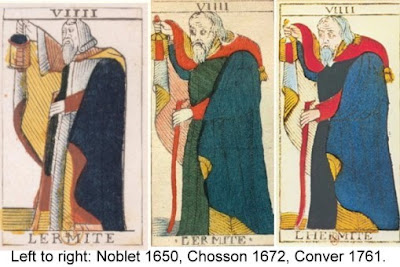
The title of this card changed over the centuries. From Vecchio, Old Man, in the early lists, it becomes "L'Eremite" in the Noblet and still in the "Chosson". Then with Conver it changes to "L'Hermite". (Daimonax points this out at http://www.bacchos.org/tarothtm/0et9mathermite3.html). Since the "h" is not pronounced in French, it may be making explicit a double meaning that existed even in the earlier title. "L'Hermite" is a word that suggests not only the hermit but also the Hermetic, which derives from Hermes Trismegistus, the legendary writer of the Corpus Hermeticum and founder of alchemy. Some people might also have seen a connection between "Trismegistus" and "Trevrizent", Wolfram's name for the hermit of Parzival (which in fact does derive from "Trismegistus" according to Kahane & Kahane, The Krater and the Grail: Hermetic Sources of the Parzival).
In the 17th and 18th centuries, alchemy was quite fashionable, and mysterious books could be purchased with tantalizing images suggestive of this card. Here is one that shows an old man in something like an egg, shutting him off from the world (Daniel Stolcius de Stolcenberg, Viridarium chymicum figuria cupro incisis adornatum et poeticia picturis illustratum 1624, fig. XCIX; I take it from Fabricius, Alchemy fig. 193 p. 109). He in isolation yet in contact with his spirit and soul (the two little birdlike creatures). The lines in the picture link him to the other world.
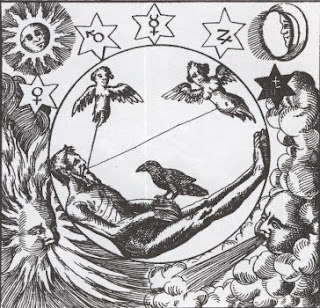
He is in one of those states of madness described by Plato, Ficino, and Erasmus. Agrippa classified it as melancholia, but not in the sense of sadness and irritability with others, but as a state of detachment from the world. To be sure, those born under Saturn are afflicted with melancholy, but some of them also see beyond the visible into the realm of prophecy and divine inspiration. Agrippa (Three Books on Occult Philosophy Book I Ch. LX) listed three types of divine melancholy. According to Tyson's commentary to the English translation, this positive side of melancholy went back to pseudo-Aristotle, in the 13th of his Problems. That is is another side of the alchemical adept: melancholy much of the time, isolating from society, but also no stranger to spiritual ascent.
Another 17th century alchemical engraving shows an old man with a lantern like the Hermit's (Michael Maier, Atalanta Fugiens, 1618, emblem XLII: I take it from Fabricius, Alchemy fig. 84 p. 55). He is the alchemist following Nature's footsteps in his alchemical experiments, as some interpret the image.
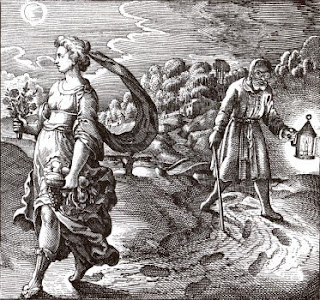
It also can be seen Wisdom, that of the Platonic "anima mundi", soul of the world, who speaks in the language of nature. That is made explicit in another version of the same scene, done . The Jewish star or hexagram signifies arcane knowledge, Kabbalah of the Christian sense that was infused into alchemy by the 17th century. (This is from the frontispiece to the Musaeum hermeticum, 1625, reproduced by de Rola Golden Game p. 184. Here the animal of the sun is the lion, as the sun astrologically governs Leo, and that of the moon the crayfish, i.e. Cancer).
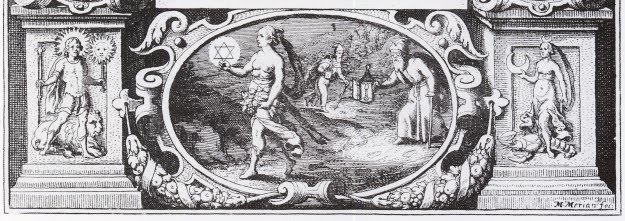
It is hard to know how far back this association between the Hermit and the alchemist goes. The alchemist, as a spiritual figure and in personality, was associated with Saturn, who was typically depicted as lame (see e.g. the illustration at http://astrolibrary.org/saturn-house.html), as in the man on crutches; even as far back as the PMB, there is a resemblance to contemporary representations of Saturn, as for example in the so-called "Tarot of Mantegna" (below).
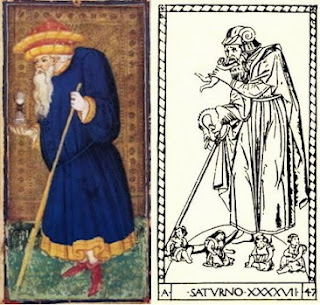
B10 - B12: TEMPERANZA, FORTEZZA, GIUSTIZIA
B10: Temperanza
The three explicit virtue cards in the tarot are Temperance, Fortitude, and Justice, in that order in the earliest lists (see the "archaic orderings" at http://l-pollett.tripod.com/cards26.htm). They are virtues of the body, the spirited part, and the mind, respectively. That division of the soul is Plato's, Republic 439-440 (see http://en.wikipedia.org/wiki/Plato%27s_tripartite_theory_of_soul). He has Temperance for the body, centered in the belly and below, Fortitude for the spirited part, centered in the heart, and Wisdom for the mind. Justice, the right relationship between the three, is also discerned by the mind rather than the other two. In these early orders, however, Justice was put up on one side or the other of Judgment (then called "Angelo", the Angel). to signify divine Justice rather than the human kind, which often is swayed by the other parts of the soul.
In later lists of the tarot trumps, however, Justice was at number 8, followed by Fortitude somewhat later, and Temperance as the one on the other side of death, at number 14. That order continued in Noblet c. 1650 and in the Marseille-style decks thereafter. Here I will take them in their most straightforward order, corresponding to Plato's.
The Temperance card is typically of a woman pouring from one vessel into another (images of the card are a few paragraphs below). From a Dionysian perspective, it shows water diluting wine. Cartari cites Athenaeus, who in turn cites Diodorus. This citation combines two passages in Diodorus. One is in IV.3 of his History
§ «For the drinking of unmixed wine results in a state of madness, but when it is mixed with the rain from Zeus the delight and pleasure continue, but the ill effect of madness and stupor is avoided» §
The other is in IV.5:
§ «He was thought to have two forms, men say, because there were two Dionysi, the ancient one having a long beard because all men in early times wore long beards, the younger one being youthful and effeminate and young, as we have mentioned before. Certain writers say, however, that it was because men who become drunk get into two states, being either joyous or sullen, that the god has been called "two-formed"» §
It is no contradiction that "two formed" applies to various opposites: not only joyous and sullen, but also young and old, male and female.
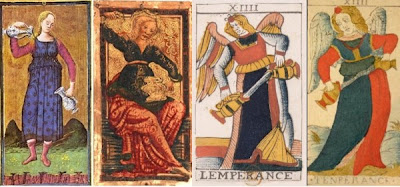
In Egypt, Seth and Osiris were opposites, as Plutarch presents them: Osiris was beneficial and a source of order, Seth harmful and the spirit of disorder. Seth's color, he tells us, was red, while Osiris's was black. Black doesn't get us anywhere, as far as the imagery of the card. But he also symbolized the Nile flood, the rising water fertilizing Isis as the land. (I surmise that the blackness was the water coming down from Ethiopia on the Blue Nile, which looked almost black). Osiris as water, of course, does relate to our card. Blue is the color most often associated with water, and they are the two colors on the dress of the lady pouring the water (above, the PMB, d'Este, Noblet, and Conver; the color that appears black in the Noblet is blue that has faded, as Flornoy restores the card at http://www.tarot-history.com/Jean-Noblet/pages/lemperance.html). Combining them, we get the mixture of good and evil that we see in our world, and which Euripides said was as it should be. It is also Seth's disordering energy moderated by the calm order of Osiris.Osiris without Seth would be dull and tasteless. Seth without Osiris would be chaos.
Plutarch associates Isis as the goddess of temperance, Of Isis and Osiris 2 (http://thriceholy.net/Texts/Isis.html):
§ «...for she is both wise, and a lover of wisdom; as her name appears to denote that, more than any other, knowing and knowledge belong to her. For “Isis” is a Greek word, and so is “Typhon,” her enemy, for he is “puffed up” by want of knowledge and falsehood, and tears to pieces, and puts out of sight, the sacred word which the goddess again gathers up and puts together, and gives into the charge of those initiated into the religion; whilst by means of a perpetually sober life, by abstinence from many kinds of food and from venery, she checks intemperance and love of pleasure, accustoming people to endure her service with bowels not enervated by luxury, but hardy and vigorous..."» §
Here she represents both Temperance and Wisdom. We might expect Plutarch to associate her with Fortitude and Justice as well; that will indeed be the case.
Another meaning for the card is suggested by the text used for Titian's Bacchanal of the Andreans,: the wine was "heavenly" and likened to the nectar of the gods. Thus a jar of it in the painting is lifted toward the sky. Likewise wine is part of the sacrament of the Christian Eucharist, flowing from God and mixed with equally celestial water. In that sense, the lady on the card might be preparing the Eucharist that forgives sin and symbolizes the eternal life promised to the believer.
In Egypt, the White Nile was the stream laden with nutrients, whitish in color from the clay it picked up, while the Blue Nile was the stream that came with few nutrients but great volume in July and August. The combination produced the rebirth of the land, both from because of the water and the nutrients. It is a physical parallel to the Christian Eucharist, wine mixed with water and then with the communion wafer.
This analysis of wine as the liquid of the Eucharist takes on more meaning in a Greco-Roman context if we consider the lady doing the pouring as the goddess Hebe. She was the cup-bearer of the gods before Hercules came to Olympus, when she married him. Even then, she sometimes took over temporarily from her replacement, Ganymede. Here is Homer in Iliad 4:1 (http://www.theoi.com/Ouranios/Hebe.html):
§ «Now the gods at the side of Zeus were sitting in council over the golden floor, and among them the goddess Hebe (Youth) poured them nectar and wine, while they in the golden drinking-cups drank to each other, gazing down on the city of the Trojans"» §
She was also famous for having a shrine where escaped slaves and prisoners could go; if they made it there and prayed to the goddess, they would win their freedom. Pausanias, writing about this shrine, says
(http://www.theoi.com/Ouranios/Hebe.html):
§ «Of the honours that the Phliasians pay to this goddess the greatest is the pardoning of suppliants. All those who seek sanctuary here receive full forgiveness, and prisoners, when set free, dedicate their fetters on the trees in the grove"» §
This story is also cited in Cartari, 1581, with a picture:
(1581 edition, http://www.uni-mannheim.de/mateot/ca...1/jpg/s038.html).
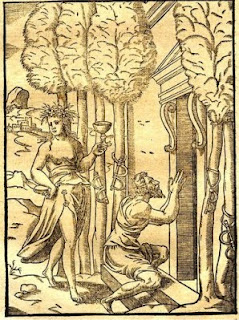
It appears that she has a cup in each hand. And you can see the prisoners' fetters hanging from the trees. She has the power to forgive transgressions. Since that is what the Eucharist is about, it would make sense to put her on the card, if that is one meaning of the scene there.
In that case, it would also make sense to put Temperance after the Death card, as the Eucharist is what has the power to overcome death. The earliest lists have Temperance below Death. Yet starting in the second quarter of the 16th century, and continuing in the Marseille decks, Temperance is number 14, just above death. If she is Hebe the cup-bearer, we have an explanation of why, of all the cards below Death that there were, it was Temperance that got elevated.
The only problem I see with this attribution is that in the Marseille cards the lady pouring the liquid has wings. I find no description in classical or Renaissance literature and art portraying Hebe in that way. Nike and Iris were, e.g. by Aristophanes, Birds 574 (trans. O'Neill):
§ «Hermes is a god and has wings and flies, and so do many other gods. First of all, Nike (Victory) flies with golden wings, Eros (Love) is undoubtedly winged too, and Iris is compared by Homer to a timorous dove"» §
Iris was the female equivalent of Mercury, a messenger of the gods. She played some role in conveying souls to the land of the dead, notably separating Dido's soul from her body; that could perhaps give Iris a place between the Death card and the Devil card. Nike, meaning victory, is also possible, if Temperance is a victory for the spirit and the Eucharist a victory over death. Artists were known to synthesize elements from different gods or goddesses. For example, Durer did a Nemesis standing on a globe, which is an attribute of Fortune. My hypothesis is that in the Marseille decks she combines Hebe with the wings of Nike or Iris: Hebe as cup-bearer, Nike as the victory over death that the two jugs represent in a Christian setting, Iris as the goddess affecting the transition to the next card.
In the earlier decks, there is no problem associating her with Hebe. In none of the PMB, the d'Este, and the Cary Sheet does she have wings (left to right below). Nor even in the Catelin Geoffrey (far right);. that card is in fact the closest to Hebe, as she is actually pouring a liquid into a container that could be drunk out of. The first winged Temperance that I know of is Noblet 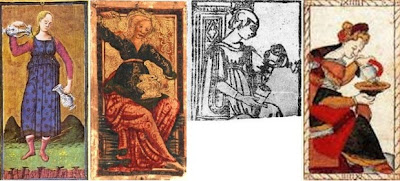 B11: Fortezza"Fortezza" is one of the four cardinal virtues of the Church, Fortitude. The lady with the lion was one conventional image of that virtue. In the Marseille decks, however, the title is "La Force". But in Italy as early as 1627 Folengo used the Italian equivalent, "Forza"--as well as "Fortezza"--in his "tarocchi sonnets"
B11: Fortezza"Fortezza" is one of the four cardinal virtues of the Church, Fortitude. The lady with the lion was one conventional image of that virtue. In the Marseille decks, however, the title is "La Force". But in Italy as early as 1627 Folengo used the Italian equivalent, "Forza"--as well as "Fortezza"--in his "tarocchi sonnets" Here is the first of four in which he uses five titles four times each, in this case to give advice to a lady who, in the larger work, drew these cards. I highlight the relevant words:
Questa fortuna al mondo è 'n Bagattella,
ch'or quinci altrui solleva, or quindi abbassa.
Non è Tempranzia in lei, però fracassa
la forza di chi nacque in prava Stella.
Sol una temperata forte e bella
donna, che di splendor le Stelle passa,
la instabil Rota tien umile e bassa;
e 'n gioco lei di galle al mondo appella.
Costei tempratamente sua Fortezza
usato ha sempre, tal che 'l Mondo e 'nsieme
la sorte de le Stelle a scherzo mena.
Ben può fortuna con sua leggerezza
ir ne le Stelle di più forze estreme:
chi sa temprarsi lei col Mondo affrena.
(Fortune in the world is like a Juggler,
who now rises someone, and than brings him down.
There is no Temperance in it, so it crushes
the strength of whoever was born under a bad Star.
Only a tempered, strong and beautiful
woman, whose splendour surpasses that of the Stars,
can make the unstable Wheel humble and low;
and she calls it to world a game of acorns.
She has always used her Strength
in a temperate way, so that she can make fun
of the World and of the chance of the Stars.
Fortune, with its carelessness, can well
use the Stars of the most extreme strength:
who can temper himself will stop it as well as the World.)
And here is its use in the fifth and final sonnet, which uses all 22 titles:
— Per qual Giustizia — disse — a te si rese
né Papa mai né, s'è, Papessa alcuna? —
Rispose: — Chi col Sol fece la Luna
tolse centra mie Forze lor difese.
([Death] said: no Pope nor Papesse was ever won
by you. Do you call this Justice?
[Love] answered: Him who made the Sun and the Moon
defended them from my Strength)
Andrea's essay on the card (http://www.letarot.it/page.aspx?id=123&lng=ENG; see also original in Italian) gives numerous examples where fortezza in the Middle Ages meant both "fortitude" and "strength". Several 15th century designs, moreover, imply physical as well as moral strength: the PMB card for the Sforza (at left below) shows a man beating a lion, probably a representation of Hercules and the Nemean Lion. Other cards, such the Charles VI (at right, probably 15th century), show a woman toppling a column. In the "Mantegna" image of c. 1470 (center) there is a lion nearby; both reference Samson, famous for his physical strength.
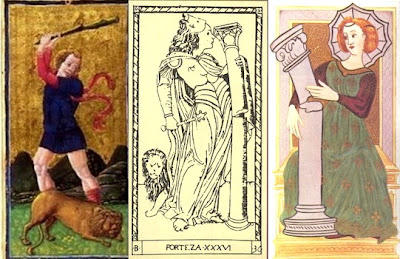 Dionysus and his Bacchantes also had that strength. People in frenzies in fact were sometimes observed not only to be bolder, but also to have unusual strength, as when Cartari observes "wine drunk out of measure makes man terrible and irascible". It is compared to that of wild animals and found even fiercer than a lion. In Euripides' Bacchae, the Maenads tear Pentheus to pieces and eat him raw, thinking that he is a wild beast, even a lion. Agive says, starting in line 1210 (http://records.viu.ca/~johnstoi/euripides/euripides.htm):
Dionysus and his Bacchantes also had that strength. People in frenzies in fact were sometimes observed not only to be bolder, but also to have unusual strength, as when Cartari observes "wine drunk out of measure makes man terrible and irascible". It is compared to that of wild animals and found even fiercer than a lion. In Euripides' Bacchae, the Maenads tear Pentheus to pieces and eat him raw, thinking that he is a wild beast, even a lion. Agive says, starting in line 1210 (http://records.viu.ca/~johnstoi/euripides/euripides.htm):
We caught this beast by hand, tore it apart
with our own hands. But where's my father?
He should come here. And where's Pentheus?
Where is my son? He should take a ladder,
set it against the house, fix this lion's head
way up there, high on the palace front.
I 've captured it and brought it home with me.
Besides this animalistic power, Dionysus had the power to tame wild animals, like the woman with the lion on the Marseille style cards (Noblet at right below), a motif present as early as the Cary-Yale (left) and repeated in the fragmengary Cary Sheet image (center): 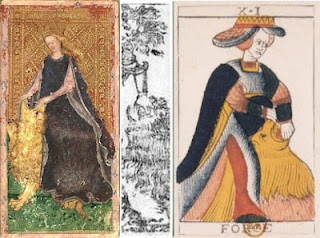 Dionysus had a similar power. In Renaissance depictions of the animals drawing his chariot, panthers and tigers are ubiquitous; in the Titian Bacchus and Ariadne for Alfonso
Dionysus had a similar power. In Renaissance depictions of the animals drawing his chariot, panthers and tigers are ubiquitous; in the Titian Bacchus and Ariadne for Alfonso
(http://www.cgfaonlineartmuseum.com/titian/p-titian11.htm) they are cheetahs; Alfonso had a pair in his private zoo. However there is an evidently tame lion in the engraving of the painting done after Raphael's cartoon of Bacchanal with Indian Elephants (http://www.1st-art-gallery.com/thumbnail/372461/1/The-Triumph-Of-Bacchus-In-India.jpg), probably inspired by a similar lion on one of the ancient sarcophagi, as drawn in 1480 by an unknown Bolognese artist. (reproduced by Sheard on p 318 of Titian 500, edited by Manco). Lions of course would not have been brought back from India; but nonetheless it is an impressive addition to the Bacchanal 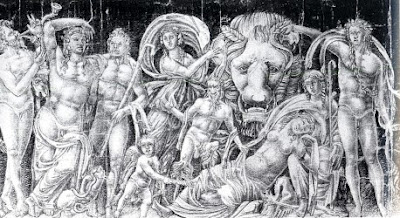 I found online one Roman sarcophagus of lionesses drawing the chariot of Dionysus and Ariadne, of which this is the relevant part
I found online one Roman sarcophagus of lionesses drawing the chariot of Dionysus and Ariadne, of which this is the relevant part 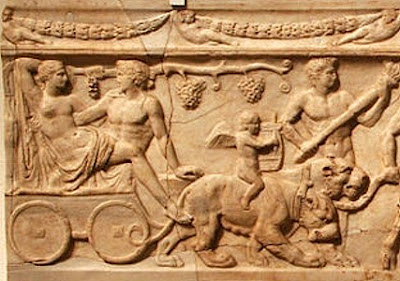 The way Bacchus and Ariadne look at each other is the same sort mutual enthrallment as in Titian's painting, and which Lorenzo di Medici put into verse c. 1475, which I have already quoted:
The way Bacchus and Ariadne look at each other is the same sort mutual enthrallment as in Titian's painting, and which Lorenzo di Medici put into verse c. 1475, which I have already quoted:
Quest’è Bacco ed Arïanna, Here are Bacchus and Ariadne,
belli, e l’un de l’altro ardenti: Handsome, and burning for each other:
perché ’l tempo fugge e inganna, Because time flees and fools,
sempre insieme stan contenti. They stay together always content.
I found this translation at http://en.wikipedia.org/wiki/The_Loves_of_the_Gods_(Carracci), accompanying yet another version of the couple in the chariot, an Antonio Caracchi 1597.
Another indication of Dionysus's power to tame those who are wild is given by Cartari. He says that ivy is sacred to Bacchus because he ties up and restrains those whose anger is likely to hurt others, just as the plant encircles whatever it is with. In Titian's Bacchus and Ariadne, there is a man with serpents wrapped around him. This detail is in Cateullus's poem, but art historians have no suggestions for what it means. The man is quite similar to the one in Correggio's Allegory of Vice (or Silenus, or Allegory of the Passions, as Campbell prefers).
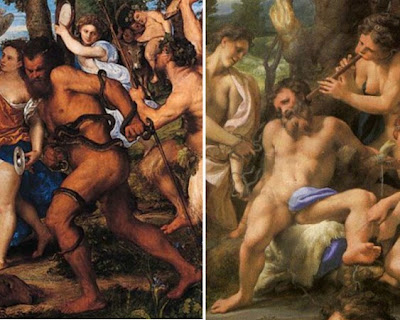 As art historians have observed, both are similar to the Laoccon statue that had been found in 1506, showing this defyer of the gods being punished for his impudence (http://en.wikipedia.org/wiki/File:Laocoon_Pio-Clementino_Inv1059-1064-1067.jpg). What makes the image Dionysian, I think, is tha tthe snakes are like ivy, restraining an overwrought man.In these various depictions of Dionysus and his band, in drama and in painting, it is again the allegorical theme of the power of wine to bring amiability in moderation and violence in excess.In Egypt, the lion was the animal of the Sun God, Ra or Re. I cannot find any Greek source describing her winning him or a lion to her side, although there may well be one, since modern accounts describe how she used his own spittle to bend him to her will. The closest match is in Plutarch, Isis and Osiris 19, is her success in winning the gods' support in recognizing Horus's legitimacy as king of all Egypt. But as Plutarch presents it, Thoth is the one who does the influencing. So conceivably the card could represent Ra, as chief of the gods, submitting to Isis under the here unseen influence of Thoth.
As art historians have observed, both are similar to the Laoccon statue that had been found in 1506, showing this defyer of the gods being punished for his impudence (http://en.wikipedia.org/wiki/File:Laocoon_Pio-Clementino_Inv1059-1064-1067.jpg). What makes the image Dionysian, I think, is tha tthe snakes are like ivy, restraining an overwrought man.In these various depictions of Dionysus and his band, in drama and in painting, it is again the allegorical theme of the power of wine to bring amiability in moderation and violence in excess.In Egypt, the lion was the animal of the Sun God, Ra or Re. I cannot find any Greek source describing her winning him or a lion to her side, although there may well be one, since modern accounts describe how she used his own spittle to bend him to her will. The closest match is in Plutarch, Isis and Osiris 19, is her success in winning the gods' support in recognizing Horus's legitimacy as king of all Egypt. But as Plutarch presents it, Thoth is the one who does the influencing. So conceivably the card could represent Ra, as chief of the gods, submitting to Isis under the here unseen influence of Thoth.
B12: Giustizia 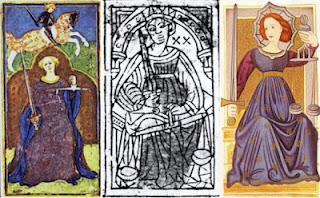 Justice originally was simply the traditional figure that illustrated that cardinal virtue of the Church. Above are the PMB of Milan in the 1450s, the Sforza Castle card, c. 1600, and the Charles VI, of sometime 1460-1480, of somewhere betwen Florence and Ferrara. As you can see, she was number 20 in that deck, the next to last in the sequence. The early lists have her either as 20th or 19th. She appears at number 8 in some early lists, those of the anonymous Motti alle signore di Pavia sotto il titolo dei tarocchi (http://l-pollett.tripod.com/cards26.htm), 2nd quarter of the 16th century, and that of Alciati, 1444; he was from Milan and was living in Lombardy at the time he made his list, although he had recently been in France. (Andy's Playing cards also has Aretino, Le Carte Parlante of 1521 However I have looked there and don't see a definite order.) And of course she is number 8 in the Marseille tarots.You will notice that in the early versions she does not have wings. Cartari, too, presents her without wings.
Justice originally was simply the traditional figure that illustrated that cardinal virtue of the Church. Above are the PMB of Milan in the 1450s, the Sforza Castle card, c. 1600, and the Charles VI, of sometime 1460-1480, of somewhere betwen Florence and Ferrara. As you can see, she was number 20 in that deck, the next to last in the sequence. The early lists have her either as 20th or 19th. She appears at number 8 in some early lists, those of the anonymous Motti alle signore di Pavia sotto il titolo dei tarocchi (http://l-pollett.tripod.com/cards26.htm), 2nd quarter of the 16th century, and that of Alciati, 1444; he was from Milan and was living in Lombardy at the time he made his list, although he had recently been in France. (Andy's Playing cards also has Aretino, Le Carte Parlante of 1521 However I have looked there and don't see a definite order.) And of course she is number 8 in the Marseille tarots.You will notice that in the early versions she does not have wings. Cartari, too, presents her without wings. 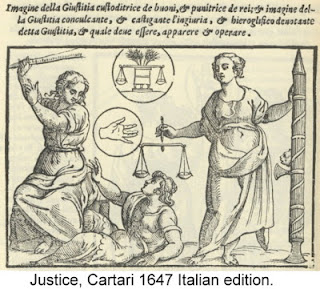 In the Noblet version, however, she does have wings (like Temperance but unlike La Force). This didn't last long: the "Chosson" removed them, a practice continued by Conver
In the Noblet version, however, she does have wings (like Temperance but unlike La Force). This didn't last long: the "Chosson" removed them, a practice continued by Conver 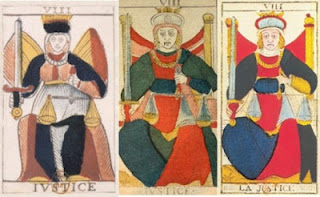 It is the Noblet, I think, that best captures the Dionysian goddess of Justice. Her name was Nemesis. She was the great equalizer, the one who brings the mighty down in Greek tragedy, an art under the patronage of Dionysus. In Garzoni's Hospital of Incurable Madness, perhaps not coincidentally, Nemesis was the goddess associated with the "tarocco madmen" (See Andrea's essay on that work, at http://www.letarot.it/page.aspx?id=109&lng=eng).In Cartari, Nemesis, unlike Justice, is depicted with wings, at least when she is rewarding the good, in this Cartari 1647 edition woodcut of her, on the left below:
It is the Noblet, I think, that best captures the Dionysian goddess of Justice. Her name was Nemesis. She was the great equalizer, the one who brings the mighty down in Greek tragedy, an art under the patronage of Dionysus. In Garzoni's Hospital of Incurable Madness, perhaps not coincidentally, Nemesis was the goddess associated with the "tarocco madmen" (See Andrea's essay on that work, at http://www.letarot.it/page.aspx?id=109&lng=eng).In Cartari, Nemesis, unlike Justice, is depicted with wings, at least when she is rewarding the good, in this Cartari 1647 edition woodcut of her, on the left below: 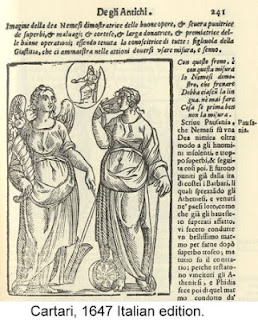 The perception of Nemesis as winged might be based on Pausanias' comments about a statue of her by Pheidias (quoted on http://www.theoi.com/Daimon/Nemesis.html)
The perception of Nemesis as winged might be based on Pausanias' comments about a statue of her by Pheidias (quoted on http://www.theoi.com/Daimon/Nemesis.html)
§ «[1.33.7] Neither this nor any other ancient statue of Nemesis has wings, for not even the holiest wooden images of the Smyrnaeans have them, but later artists, convinced that the goddess manifests herself most as a consequence of love, give wings to Nemesis as they do to Love» §
As punisher of the bad, she also is shown with a wheel, perhaps similar to the Wheel of Fortune, as she gives her victims a reversal of fortune. This is perhaps based on knowledge of Roman sculptures of the goddess, such as the one pictured at http://commons.wikimedia.org/wiki/File:Nemesis_Getty_Villa_96.AA.43.jpg. This one, true to Pausanias' comment, is depicted with wings.In Greek tragedies, of which Dionysus was the patron, the reversal happens at the end of the play, when the protagonist suffers in consequence of his character flaws. Similarly, Justice was put at the end of the tarot sequence in all the early lists. From a Christian perspective, it is that by which those who do not measure up are excluded from Paradise. But in the "Marseille" order Justice appears earlier, which befits a happy ending: the high-flying charioteer is laid low by Justice as Nemesis, after which true initiation beings.For Plutarch, Justice is simply again Isis, Of Isis and Osiris 3 (http://thriceholy.net/Texts/Isis.html):
§ « ...of the Muses at Hermopolis they call the foremost one “Isis,” and “Justice-Wisdom,” as hath been stated"» §
This might be another reason for Noblet's giving her wings. Plutarch says she took the form of a swallow. The light, fleshly color in the Noblet Justice's midrift might have been meant to suggest bare skin; that is certainly the way Flornoy interpreted it in his restoration, below. Since there are no nipples, one is free to make one's own interpretation.
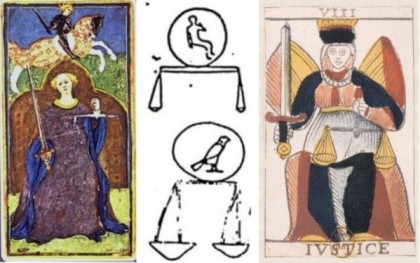 There is also the sign of Scales as it was in the Dendera zodiacs (middle above, from Desroches-Noblecourt, Le Fabuleux Heritage de l'Egypte p. 331). One of these images showed a bird above the fulcrum of the balance. That could have been Isis, based on the Greek texts known by 1650--or Horus, if it was known by then that the hawk was one of his forms.This essay continues at: Dionysus and the Historical Tarot 4
There is also the sign of Scales as it was in the Dendera zodiacs (middle above, from Desroches-Noblecourt, Le Fabuleux Heritage de l'Egypte p. 331). One of these images showed a bird above the fulcrum of the balance. That could have been Isis, based on the Greek texts known by 1650--or Horus, if it was known by then that the hawk was one of his forms.This essay continues at: Dionysus and the Historical Tarot 4